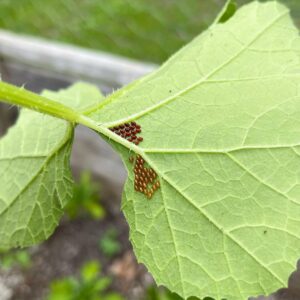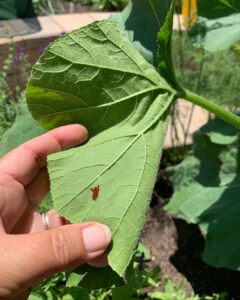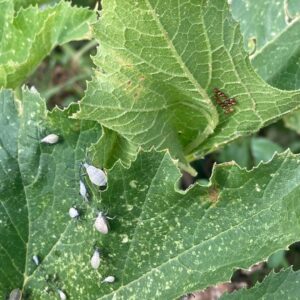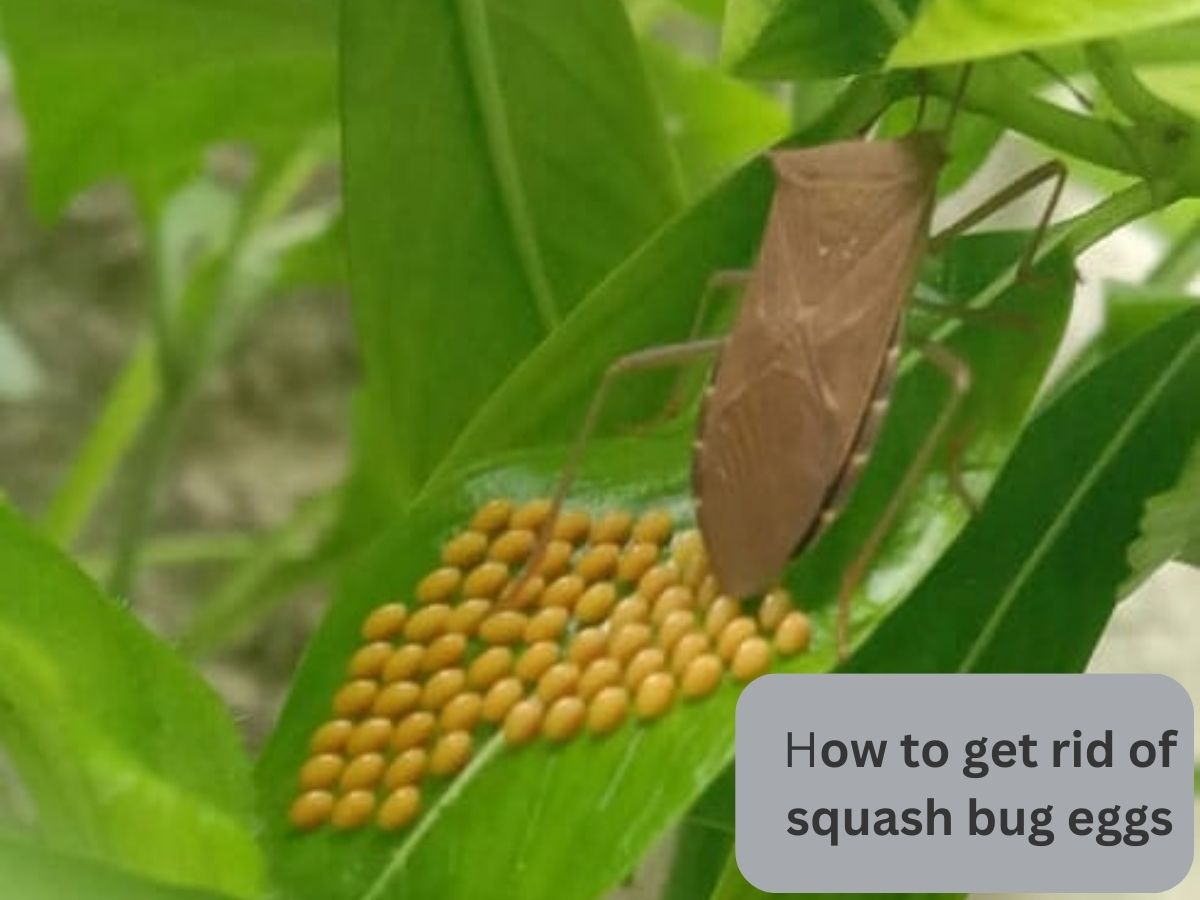Are you tired of battling those stubborn squash bug eggs in your garden? We feel your frustration; Squash bugs can wreak havoc on your precious plants, causing stunted growth and even plant death if left unchecked. But fear not, because we’ve got you covered with our comprehensive guide on how to get rid of squash bug eggs once and for all.
Squash bugs can be a real nightmare for gardeners. Their eggs are laid in clusters on the undersides of leaves and can quickly hatch into hungry nymphs, causing damage to your beloved squash plants. But by taking immediate action, you can prevent these eggs from turning into a full-blown infestation.
In this article, we’ll dive deep into the world of squash bug eggs and arm you with effective strategies to combat them. From identifying these sneaky eggs to implementing preventive measures and exploring natural and chemical control options, we’ll leave no stone unturned. So, get ready to bid farewell to those unwanted invaders and restore harmony in your garden.
Understanding Squash Bug Eggs
Squash bug eggs are small, about 1/16 inch in size, and have a distinct coppery-brown color. They are often laid in clusters and have a flattened shape with slight ridges. When freshly laid, the eggs have a shiny appearance, but as they mature, they become darker.
Squash bugs prefer to lay their eggs on the undersides of leaves, particularly near the veins. They have a preference for leaves close to the ground, where they can find protection and warmth. You may also find squash bug eggs on stems or the base of plants.

The time it takes for squash bug eggs to hatch varies depending on temperature and environmental conditions. Generally, it takes around 1 to 2 weeks for the eggs to hatch. However, in warmer climates, they may hatch sooner, while cooler temperatures can extend the incubation period.
Understanding the appearance and behavior of squash bug eggs, as well as where they are commonly found and their hatching time, is crucial for effective detection and control. In the next section, we’ll explore how to detect squash bug eggs and identify their presence in your garden.
Identifying Squash Bug Infestations
Signs of squash bug presence in your garden
Detecting squash bug activity early on is key to preventing infestations. Look out for these signs that indicate the presence of squash bugs in your garden:
- Wilting or yellowing leaves: Squash bugs feed on plant sap, which can cause leaves to wilt, turn yellow, or even die prematurely.
- Stunted growth: Infested plants may show reduced vigor and fail to grow as expected.
- Brown or black spots on leaves: Squash bugs inject toxic saliva while feeding, which can lead to the formation of dark spots on leaves.
- Excrement or “frass” on leaves: Squash bug droppings resemble small, dark specks and are often found on leaves and stems.
Inspecting leaves, stems, and undersides for eggs
To identify squash bug eggs, conduct regular inspections of your squash plants using these tips:
- Check the undersides of leaves: Carefully examine the undersides of leaves, especially near the veins, for clusters of small, coppery-brown eggs.
- Inspect stems and plant bases: Squash bugs may also lay eggs on stems or the base of plants, so be thorough in your inspection.
- Use a magnifying glass if needed: Squash bug eggs can be tiny, so using a magnifying glass can help you spot them more easily.
By being vigilant and regularly inspecting your plants, you can catch squash bug eggs before they hatch and take necessary action to protect your garden. In the next section, we’ll discuss preventive measures to minimize the risk of squash bug infestations.
Natural Methods to Eliminate Squash Bug Eggs
Getting rid of squash bugs’ eggs before they hatch is important. This will prevent infestations and keep your garden thriving. Below are the various natural ways to eliminate squash bugs’ eggs.
Handpicking and destroying eggs
One effective and eco-friendly method to control squash bug eggs is to manually remove them. Here’s how:
- Wear gloves to protect your hands.
- Inspect your plants for squash bug eggs, focusing on the undersides of leaves and stems.
- Gently scrape the eggs off the plant using your fingers or a small tool.
- Collect the eggs in a container filled with soapy water or seal them in a plastic bag and dispose of them.
Companion planting for repellent effects
Companion planting can help deter squash bugs and protect your squash plants. Consider planting the following companion plants alongside your squash:
- Nasturtiums: The pungent scent of nasturtiums repels squash bugs.
- Marigolds: Marigolds emit a strong fragrance that acts as a natural deterrent.
- Radishes: Interplanting radishes with squash can confuse and deter squash bugs.
Using beneficial insects as predators
Introducing beneficial insects that prey on squash bugs can be an effective biological control method. Consider these options:
- Parasitic wasps: Certain species of parasitic wasps lay their eggs inside squash bug eggs, effectively killing them.
- Tachinid flies: These flies target squash bugs and their eggs, providing natural control.
Neem oil spray:
Neem oil, derived from the neem tree, has insecticidal properties and can be used as a spray to deter and kill squash bugs and their eggs. Follow the product instructions for proper application.
Diatomaceous earth:
Sprinkling food-grade diatomaceous earth around your squash plants creates a barrier that damages the exoskeletons of squash bugs and dehydrates them. Apply it carefully and reapply after rain.
Garlic and pepper spray:
Create a homemade spray by combining minced garlic, hot pepper flakes, and water. Strain the mixture and spray it on your squash plants to repel squash bugs.
Mulching:
Applying a layer of organic mulch around your squash plants can discourage squash bugs from laying eggs near the base of the plants.
By combining these natural methods, you can significantly reduce squash bug egg populations in your garden without resorting to chemical solutions. In the next section, we’ll explore chemical control options for more severe infestations.

Chemical Control Options
Chemical control should be considered when natural methods have been unsuccessful or when squash bug infestations are severe. It’s important to exhaust all non-chemical options first and only resort to pesticides when necessary. Follow these guidelines for responsible pesticide use.
Garden Safe Multi-Purpose Garden Insect Killer:
Defend your squash plants against the relentless squash bugs and their eggs with Garden Safe Multi-Purpose Garden Insect Killer. This versatile spray is specially designed to target and eliminate squash bugs, ensuring the health and vitality of your garden.
Its fast-acting formula delivers on-contact control, swiftly eradicating these pests. With Garden Safe Multi-Purpose Garden Insect Killer, you can trust that your squash plants are protected throughout the growing season. Say goodbye to squash bugs and hello to a flourishing squash patch.
BioAdvanced Vegetable and Garden Insect Spray:
BioAdvanced Vegetable and Garden Insect Spray is your go-to solution for tackling squash bugs and their eggs. This powerful insect spray provides comprehensive protection for your squash plants, ensuring a bug-free environment.
Its advanced formula targets squash bugs at all stages of their life cycle, from eggs to adults, effectively eliminating these destructive pests.
With BioAdvanced Vegetable and Garden Insect Spray, you can enjoy the peace of mind that comes with a healthy, thriving squash garden. Take control and bid farewell to squash bugs, as your plants flourish and produce abundant harvests.
Remember, when using chemical insecticides, always follow the instructions on the product label carefully. Take necessary precautions to protect yourself, other beneficial insects, and the environment. Limit the use of chemical control methods and prioritize integrated pest management practices for long-term sustainability.
Prevention and Maintenance Tips
Crop rotation to disrupt the squash bug lifecycle
Implementing crop rotation is crucial in preventing squash bug infestations. By rotating your squash plants to different areas of your garden each year, you disrupt the squash bug’s lifecycle and reduce their population. Avoid planting squash or related plants in the same spot for consecutive years.
Regular weeding and sanitation practices
Keep your garden free from weeds and debris, as they provide hiding places for squash bugs. Regularly remove weeds and clean up fallen leaves or plant debris around your squash plants. This reduces the favorable environment for squash bugs and makes it harder for them to establish a presence in your garden.
Installing row covers for protection
Covering your squash plants with lightweight row covers can act as a physical barrier, preventing squash bugs from laying their eggs on the plants. Make sure the covers are securely anchored to prevent pests from accessing your plants. Remove the covers when the plants need to be pollinated.
Attracting beneficial insects to your garden
Encourage the presence of beneficial insects that prey on squash bugs by providing them with suitable habitats and food sources. Plant flowers such as daisies, yarrow, and asters to attract beneficial insects like ladybugs and lacewings. Additionally, avoid using broad-spectrum insecticides that harm beneficial insects.
By incorporating these prevention and maintenance tips into your gardening routine, you can reduce the risk of squash bug infestations and maintain a healthier garden ecosystem.

How to get rid of squash bug eggs FAQs?
Can squash bugs harm other plants besides squash?
Yes, squash bugs are not limited to squash plants alone. They can also feed on and damage other plants within the cucurbit family, such as zucchini, pumpkins, cucumbers, and melons.
In some cases, they may even target plants outside the cucurbit family if their preferred host plants are not available. It’s important to be vigilant and monitor your entire garden for squash bug activity to protect all susceptible plants.
How long does it take for squash bug eggs to hatch?
The incubation period for squash bug eggs can vary depending on factors such as temperature and environmental conditions. Generally, it takes around 1 to 2 weeks for squash bug eggs to hatch. However, in warmer climates or during hot weather, the eggs may hatch sooner.
On the other hand, cooler temperatures can prolong the hatching process. Regular monitoring and early detection are essential to take appropriate action before the eggs hatch and the nymphs start causing damage.
Are squash bug eggs harmful to humans or pets?
Squash bug eggs themselves are not harmful to humans or pets. They do not pose any direct danger. However, it’s important to note that squash bugs and their nymphs have piercing-sucking mouthparts and can release a pungent odor when disturbed.
Additionally, while squash bugs do not typically bite humans or pets, they may cause skin irritation or allergic reactions in some individuals. It’s advisable to wear gloves when handling squash bug eggs or squash bug-infested plants to minimize direct contact and potential skin reactions. As a general precaution, it’s best to avoid ingesting or allowing pets to consume squash bug eggs or infested plants.
Conclusion
In conclusion, effectively dealing with squash bug eggs is essential for maintaining a healthy garden. By understanding their appearance, inspecting your plants regularly, and employing natural methods like handpicking, companion planting, and attracting beneficial insects, you can significantly reduce squash bug populations without resorting to chemical control.
However, when infestations become severe, carefully using insecticides like pyrethrin-based or permethrin-based options can provide an additional line of defense. Remember to prioritize prevention and maintenance practices such as crop rotation, regular weeding, sanitation, and row covers to minimize the risk of squash bug infestations.
By implementing these strategies, you can protect your squash plants and preserve a thriving garden ecosystem. Stay vigilant, take prompt action, and say goodbye to squash bug eggs for good.


